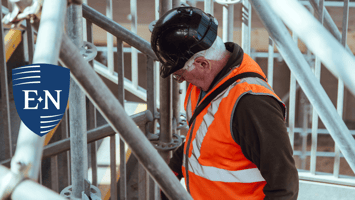Safety consultation services aren’t just about compliance – they’re about protecting your people...
The Power of Safety Consulting: Your Guide to Building a Culture of Safety at Your Business

Safety, and safety consulting, isn’t just about checking boxes — it’s about protecting your people and keeping your business running smoothly. Creating a culture where safety is second nature boosts morale, prevents accidents, and ensures the longevity of your business. Think of safety consulting as one piece in the larger picture of risk management at your business. When you build a culture of safety, it can help your insurance rates, it increases employee retention, it helps prevent your workforce from missing time on the job, and it helps ensure you avoid compliance or regulations.
When you start to think of risk management holistically, it changes the way you approach every part of your business, safety included.
Today, let’s dive into safety consulting and how it can fit into your broader risk management strategy. Think of this guide as your roadmap to a safer, more productive workplace. From risk assessments to implementation strategies, safety consulting helps you build a strong framework that prioritizes safety at every level of your company.
Ready to take the next step? Let’s dive in and make safety not just a goal, but a way of life in your workplace.
Understanding Workplace Safety Culture
Safety isn’t just a set of rules — it’s a mindset.
In 2023, private industry saw 2.6 million nonfatal workplace injuries and illnesses and 5,283 fatal work injuries. Those aren’t just numbers; they represent real people, real families, and real consequences. When your thinking about safety consulting, think about your company’s daily operations. Employees are more likely to follow best practices, report hazards, and actively participate in training, which helps prevent tragedies like these.
.png?width=1109&height=609&name=Safety%20Consulting%20-%20BLS%20Stat%20Graphic%20(2).png)
As we’ve talked about before, leadership is key to driving this cultural shift. When executives and managers lead by example, safety becomes more than just a set of rules— it becomes a core value and creates a workplace where everyone looks out for one another.
A strong safety culture also thrives on open communication. If an employee feels comfortable speaking up, they’re more likely to report unsafe conditions and help prevent accidents before they happen.
While building this culture is important, it’s even more crucial to regularly reinforce it. To do this, your business should provide regular training, resources, workshops, and drills that help employees recognize and reduce risks. Implementing these practices keeps safety top of mind while also showing a real commitment to continuous improvement. This proactive approach is a fundamental part of holistic risk management, ensuring that safety is not just reactive but preventative.
In the end, prioritizing safety doesn’t just prevent accidents — it creates a stronger, more successful workplace where employees feel safe and valued.
Benefits of Safety Consulting
Keeping up with safety regulations and managing risks can be overwhelming— which is where safety consulting come in. They bring new perspectives, deep expertise, and real-world solutions that help you identify hazards, develop policies, and implement best practices tailored to your business.
Safety consulting also brings a fresh set of eyes. It’s easy to miss risks when you see them every day, but a trained expert can spot overlooked hazards and regulatory violations while offering practical, tailored solutions. This outside perspective is invaluable for businesses committed to improving and maintaining high safety standards.
Consultants also save you money in the long run, making it a smart choice for businesses focused on both safety and savings.
Workplace injuries and illnesses cost employers nearly $1 billion per week in direct workers' compensation costs alone. And that’s just the tip of the iceberg — lost productivity, training replacements, accident investigations, and legal fees can drive those costs up even more.
A proactive safety program reduces workplace injuries, lowers insurance premiums, and minimizes workers’ compensation claims. Simply put, investing in workplace safety protects both employees and the bottom line.
Key Safety Consulting Services
Safety consulting isn’t a one-size-fits-all solution. Every industry and workplace comes with its own challenges, which is why a tailored, comprehensive, and holistic approach is essential.
For example, at 10 employees, you’re required to keep OSHA logs (but not submit them), at 20 employees, you need to be submitting OSHA logs. When you are nearing 30 employees, it’s time to start seriously considering a full-time safety director or finding safety consulting help.
Here are some must-have services your safety program should include:
In-Depth Audits and Assessments
These evaluations uncover potential hazards, ensure compliance with regulations, and measure the effectiveness of existing safety protocols. After the audit, consultants provide detailed reports with actionable recommendations to help businesses enhance their safety practices and stay OSHA-compliant.
This process also identifies broader operational risks, helping companies strengthen their overall risk management strategies.
Customized Training Programs
These programs cover essential topics like hazard recognition; first aid, CPR, and AED usage; emergency response; equipment safety; OSHA compliance; PPE usage; and more, ensuring employees are well-prepared to handle workplace risks.
Safety Management Implementation
By working closely with organizations, consultants create safety plans that align with company operations and culture. With a solid system in place, businesses can continuously monitor, refine, and improve their safety performance over time.
Broader Risk Management Advice
As you de-risk your business, safety is an important component. But if your safety director or consultant doesn’t understand the bigger picture, you may be exposing yourself to other unknown risks or leaving money on the table. For example, your insurance provider should be crafting a narrative to the carrier that explains all the efforts you're putting in to ensure a safe workplace. This, in turn, can lower your insurance rate — even if your E-Mod is higher than you’d like.
Likewise, your Human Resources team likely needs to be involved in back-to-work programs, potential on-site care options, employee retention data, and potentially preferred healthcare providers.
Safety consulting in a silo can help with the day-to-day, but it won’t create the holistic, long-term savings that holistic risk management provides.

Importance of OSHA Training
The Occupational Safety and Health Administration (OSHA) establishes safety standards that employers must follow to protect their employees from workplace hazards.
OSHA training is like the seatbelt of workplace safety — basic but essential. When you partner with an Ellerbrock-Norris safety consultant, you can make sure that your business meets important OSHA compliance standards. You also equip employees with the knowledge to recognize risks, follow best practices, and respond effectively to workplace hazards.
One of the biggest perks of OSHA training is prevention. When employees know what to look for and how to handle risks, accidents drop significantly. Additionally, a workforce that feels confident about safety is more engaged, productive, and accountable.
Beyond just compliance, a strong OSHA training program enhances your company’s reputation and credibility.
With nearly 1,000 OSHA rules to abide by, training should be conducted by a certified OSHA trainer (all Ellerbrock-Norris safety consultants are OSHA certified trainers). They know the best ways to present information, get your employees engaged, and can prioritize training to your specific needs.
Safety Consulting and Jobsite Inspections
A jobsite inspection shouldn’t be just about checking boxes, it should be about keeping people safe. It’s a key part of keeping your culture of safety and prioritizing compliance.
Every jobsite should be inspected annually at least, and depending on the size of your business and your specific services, jobsite inspections could be needed quarterly, monthly or even weekly in some cases. And remember: The safety consultant is on your side. They aren’t looking for violations to report. They are looking for opportunities to create a safer workplace.
During a safety consulting inspection, your consultant will conduct thorough evaluations and checklists, looking at everything from equipment usage to employee behavior. This ensures that nothing is overlooked.
After an inspection, consultants provide detailed reports that outline key findings and actionable solutions. This isn’t just paperwork: it’s a roadmap to safer daily operations. By having a continuous feedback loop and addressing small hazards early, you can prevent them from becoming costly problems down the line.
Another bonus? Inspections give consultants a chance to engage directly with employees. That hands-on approach fosters a culture of accountability that encourages workers to take ownership of their own safety.
Choosing the Right Safety Consulting Firm
Choosing the right safety consulting firm is key to making meaningful, long- term improvements. When looking for the right fit, consider these key factors:
Industry Experience
Each field has its own unique safety challenges. When you partner with a firm that understands your field’s specific risks, you know that your business is getting the best, most tailored solutions.
Range of Services
Look for a firm that provides a well-rounded, holistic risk management approach. This includes safety audits, training programs, and jobsite inspections. This ensures that your strategies tackle immediate risks and long-term goals in all areas of your business, not just safety.
Collaborative Approach
The best consultants work alongside your team instead of just handing you a checklist. When a safety consultant works closely with you, they’re able to create safety initiatives that directly align with your company’s culture and goals.
Proven Results
The right safety partner will help you go beyond compliance to create a safer, stronger workplace. A track record of helping businesses implement risk management strategies is a good indicator of long-term value.
Working with Us: Safety Consulting at Ellerbrock-Norris
At Ellerbrock-Norris, we’re all about making safety consulting practical, effective, and easy to integrate into your operations. Whether you need a one-time assessment or ongoing support, our safety consulting services are tailored to your industry and your business goals. We don’t just focus on compliance; we help you develop a risk management strategy that safeguards your business in the long run.
For companies looking to take safety to the next level, our ENCORE Safety Network offers extra resources, leadership training, and hands-on support. With jobsite inspections, toolbox talks, and expert-led webinars, ENCORE helps businesses keep safety at the forefront of their operations.
Ready to strengthen your safety program? Contact us to schedule a time to talk.





